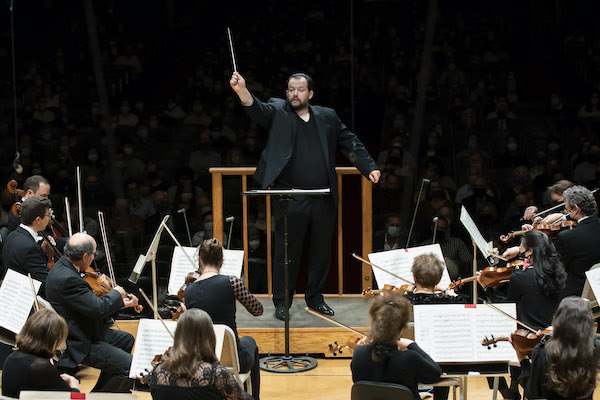Nelsons, BSO illuminate contrasts and convergence in Russian program

Andris Nelsons conducted the Boston Symphony Orchestra in music of Guibaidulina and Rachmaninoff Thursday night at Symphony Hall. Photo: Winslow Townson
The secret of statecraft, Otto von Bismarck once offered, is to make a good treaty with Russia.
On Thursday night at Symphony Hall, Andris Nelsons and the Boston Symphony Orchestra tested a comparable truism about concert programs, presenting a night of contrasting pieces by Sofia Gubaidulina and Sergei Rachmaninoff.
Actually, outside of some stylistic divergences, Gubaidulina’s The Light of the End and Rachmaninoff’s Symphony No. 3 share more than a few traits. Both are tightly motivic, rivetingly scored, and thrillingly virtuosic. They also traffic in similar—though not identical—musical patterns.
Written for the BSO in 2003, The Light of the End’s title is whimsical, referring to the radiant sound of antique cymbals at the piece’s conclusion. Not much else in it, though, is lighthearted.
Gubaidulina, who turns ninety on Sunday, has long been something of a mystic Modernist. Her music is often infused with a type of spirituality that flows from her devout Russian Orthodox beliefs. But the music is neither overtly dogmatic nor does it shy away from contemporary techniques and harmonies.
Such is the situation with The Light of the End. Lasting around twenty-five minutes, the piece alternates three primary gestures: a swirling, stormy figure passed through the orchestra; chorale-like statements for strings and woodwinds; and a cantorial melodic line that appears most prominently in the brasses and cellos.
The piece’s harmonic conflict is generated by the discrepancies between the naturally occurring pitches of the overtone series and the tempered scale. While this results in moments of biting dissonance, there are frequent episodes of diatonicism, especially around The Light’s dancing middle part and again near the end.
Thursday’s performance was focused and propulsive. Nelsons’ conducting ensured that everything moved well; accordingly, The Light’s architecture was about as smartly shaped as one might have wanted.
That said, the BSO’s vigorous reading didn’t quite redeem Gubaidulina’s discursive approach to form in the piece. The music’s argument might be much stronger if it were condensed by about a third. Nor did it compensate for the limitations of her reliance on gestural figurations. Indeed, by the end, some of the latter (particularly the wild scale episodes) simply felt redundant.
Nevertheless, The Light’s quiet moments (especially the duets between solo horn and cello) burned intensely. Its climaxes— including the Rheingold-esque apogee for brasses playing arpeggios on the overtone series—were resplendent, if not always texturally pristine. Regardless, Nelsons ensured that the music’s expressive contrasts were boldly delineated.
He largely managed the latter, too, in Rachmaninoff’s Symphony No. 3.
Completed and premiered in 1936, the Russian master’s final work in the genre has never garnered as robust a following as the Second Symphony or Symphonic Dances. Even so, the piece is brilliantly scored and its melodic profile offers ample attractions.
On Thursday, the Third’s big first movement was warm-toned and flexibly phrased. Its lyrical moments, from the burnished account of the second subject to the violin and cello solos in the recapitulation, soared. The development was aptly stormy, its coda fiercely passionate.
Nelsons drew plenty of character from the BSO in the central movement, too. Its slow outer thirds were lovingly colored and texturally transparent. Meanwhile, the darkly impish central scherzo drove with nimble force.
In the finale, the orchestra again reveled in Rachmaninoff’s mellifluous writing, especially that for woodwinds over the movement’s last third. While some of the brisker moments didn’t quite settle Thursday night—the fugue, in particular, was occasionally ragged—Nelsons’ direction ensured that the fragments of the “Dies irae” chant were discreetly woven into the musical fabric.
Prior to beginning the printed program, the BSO played the “Air” from Bach’s Orchestral Suite No. 3 in memory of BSO conductor emeritus Bernard Haitink, who died earlier in the day in London. Theirs was a fittingly resonant, touching performance in memory of a much-loved colleague.
The program repeats 1:30 p.m. Friday and 8 p.m. Saturday at Symphony Hall. bso.org; 888-266-1200
Posted in Performances



